
Crystals of Time (2013 - PC)
Crystals of Time is a Hidden Object Game in which you play as a goth girl who's trying to solve the mystery of her father's disappearance at an abandoned old rundown mansion. The artwork is nice, although the animation is more limited than in some others I've seen in this genre. At least the Hidden Object Scene artwork quality is consistent with the rest of the game.
As is implied by the title, the gimmick for this HOG is that in some rooms, the Hint Crystal provides an option to travel back in time. This offers a glimpse of the mansion's former splendour and adds to the mystery, but it had more potential than what was used. Only two rooms in the mansion and one more outside of it have time travel come into play, and it seems like an opportunity to have this slowly reveal past events before your eyes, rather than just reading about them in notebooks and diaries you find here and there, was sorely missed.
Gameplay is fairly standard, "Look for objects, find where to use them, solve a mini-game puzzle here and there". Most of it is very easy and the hardest part is just figuring out where to go to find something when you're stuck. You're often forced to backtrack and revisit the same rooms and comb over the same Hidden Object Scenes multiple times, and are even asked to find the same exact objects on these subsequent visits.
One thing I really liked about Crystals of Time is that it did give me the impression of exploring a creepy old mansion, which is something I have a strange affinity for, although it loses focus on it after awhile, and then the abruptness of the ending is lame. With absolutely no achievements (in-game or otherwise), and no optional sidequests, there is almost no reason to ever replay it, so expect about five hours of play time at the most.
Rating: 2.5/5

Haunted House (1981 - Atari 2600)
Speaking of exploring creepy old mansions, Haunted House has been one of my most nagging "childhood demons" that I have finally exorcised some 30 years after its release. The problem was that I didn't understand it. I could beat the first two difficulty settings, and that was it. On Levels 1 and 2, the mansion either has no doors or they aren't locked. So, it's pretty much a no-brainer to wander around uninhibited.
On Level 3 and up, some of the doors are locked, requiring a key, and that's what I didn't understand. You can only carry one item at a time, so I had no idea how to get a piece of the urn (the game's macguffin) to the other side of a locked door if you can't carry the key with it and the door relocks once you pass through it.
I guess I didn't read the manual carefully enough or didn't have it available or something, but I never knew until recently that you can navigate the entire mansion without the key. It's just a matter of memorizing where the staircases go and which doors are unlocked.
With that knowledge in mind, and nine lives to spare, I was able to clear every difficulty setting (1-9) in about an hour. Level 9 changes the layout of the maze, and I never even figured out how to get to Floor 4, but it didn't matter. When I finally beat it, I found all the pieces of the urn on the first two floors.
Which brings me to my point of how randomness plays a huge role in whether you'll make a successful run. There's no way to know if an enemy is on the other side of a staircase or door before you cross it, and if there is, you'll die with no chance to evade it. On the higher settings, if you don't find the magic wand that makes you invicible fairly early (it's randomly generated in one of the rooms, as are all objects), you'll be wiped out a lot, making it a lot harder to win, even if you manage to find the urn.
On the highest settings, the ghost is not repelled by the wand, and will chase you relentlessly on sight. This means any encounter with it will result in a lost life. So, you'll just have to hope you don't run into the ghost too much if you want to win.
I suppose this randomness could lend some value to replay - the whole, "Will I make it this time, and if likely not, can I beat the odds?" appeal, I suppose. At least it was something different and unusual, and fairly well-executed for its time. But like many Atari 2600 games, even those I'd rank amongst the best, you'll probably lose interest in it once you feel you've mastered it.
Rating: 2.5/5

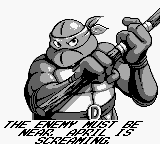
Teenage Mutant Ninja Turtles: Fall of the Foot Clan (Gameboy - 1990)
It's pretty clear that what Konami was going for in this game was great character art, and on that level they succeeded. The turtles, Foot Soldiers, mousers, and bosses (Rocksteady, Bebop, Baxter Stockman, Shredder, and Krang) all look amazingly identical to their cartoon counterparts, minus the color. The between-level cinema scenes look like they could've been traced directly from cels.
The game itself, however, is...lacking, to say the least. It is ridiculously easy (one of the easiest Game Boy games I've ever beaten), and has little level design or variety to speak of. Walk left and right, whack things with your ninja weapon, and occasionally, jump over or jump kick something. The final boss, Krang in his robot body, is one of the most unintentionally-hilarious bosses I've seen in awhile. Yes, he does look like the cartoon character, but at the cost of not being very mobile - a sprite this size takes up a good portion of the screen and barely moves. He wanders a bit and gets stuck, and then you can just whack him until victory.
If you want a finely-crafted Game Boy sidescroller from Konami, I would strongly recommend checking out Kid Dracula and/or Operation C instead of this.
Rating: 1.5/5
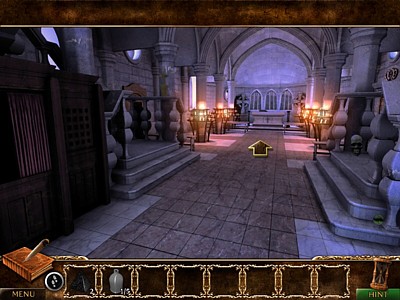
Where Angels Cry (PC - 2013)
Last month, I was getting concerned about Hidden Object Games in which the actual HO scenes were taking a back seat to the rest of the game. Well, it's finally happened - here's one that has NO traditional hidden object scenes where you find things from a list of objects and one or two become useful items. Instead, it cuts right to the point - you look over a picture, figure out what you can take with you, and then use it somewhere else. Eventually, you'll be asked to solve some puzzles, too, and at least I can say most of the puzzles in this game are not just rehashes of the same ones I've been seeing in HOGs since I first played The Edgar Allan Poe Conspiracy, and they aren't just "flip the tiles", either. Some of them might seem familiar, but I liked the ones I hadn't done a million times by now.
In a story the developers admitted was inspired by The Name of the Rose, you play as a Catholic monk who goes to investigate the disappearance of Brother John at a monastery in the Alps, as well as a statue reported to be crying tears of blood. It would've been better if you could've solved the mystery more through clues than meeting a ghost who pretty much sums the whole thing up. And I always find it hilarious when games with such heavy thematic elements find excuses to make you do mundane things, like plant a cabbage garden and groom a horse.
Several hours and reels of ridiculous voice acting later, you'll arrive at the game's abrupt conclusion, because it's super-easy, even for games in this genre. There are in-game achievements, which give it a little replay value, but the one for beating the Match 3 minigame on your first try is cheap, considering some luck plays a role in that, and it doesn't occur until about halfway through the game.
Rating: 2.5/5



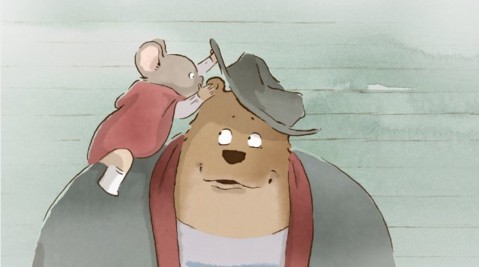
Ernest & Celestine (Streaming Video - 2012)
An animated feature based on a children's book that got an Academy Award nominaton, Ernest & Celestine felt very mediocre while I was watching it, and then fell apart more and more in my mind as I thought about it afterwards.
I have an issue with using animals to teach children lessons about racial tolerance. The problem is that, just like with The Land Before Time V, the animals used are almost always completely different species with completely different dietary needs and roles in nature. In the case of Ernest & Celestine, it's a bear and a mouse. Ernest is a bear who passed up the chance to be a judge for an unsuccessful acting career. Celestine is a mouse who would rather be an artist than a dentist - the profession for which she is currently in training. They meet through some weird circumstances and go on a bizarre crime spree.
The problem with using animals as different as a bear and a mouse is that no matter what the movie does with it, the thought is always in the back of my mind that in reality, this would not work. The likelihood of the mouse getting eaten by the bear is pretty high. A fear of mice completely infesting one's living quarters isn't exactly unfounded. This nasty little nagging thought can potentially undermine the lesson.
The finale is a ridiculously overwrought courtroom scene (still always think of Roger Ebert's Patch Adams review when a non-legally-themed work of fiction has a courtroom scene for a third act) where everyone is yelling at each other, including clunkers like, "How dare you question the foundations of our society?!?!", and "Is it a crime to be friends with a bear!?" Since Ernest and Celestine can't get anyone else to see their point of view, they do the one thing that works every time in fiction to resolve the situation: They save their antagonists' lives.
As an adult, it's easy to be skeptical of "follow your dreams" plots enough as it is. Here, it's particularly bad, because Ernest is still not employed by the movie's end and has no discernible means of supporting himself, and Celestine is still drawing and her skill has improved, but she does not seem to support herself with it.
Rating: 2/5
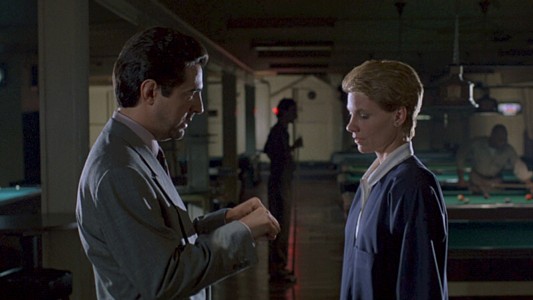
House of Games (Streaming Video - 1987)
When I got done watching David Mamet's House of Games, I was left thinking about the movie in terms of its acts: It has a great first act, a convoluted second act for which I correctly predicted the outcome, and a disappointing third act.
Lindsay Crouse is a psychiatrist who seems to have some mental issues of her own, mainly an almost emotionless, possibly psychopathic method of responding to everything, like Cameron from Terminator: The Sarah Connor Chronicles, and an inability to "have fun". Through one of her patients, who has a compulsive gambling problem, she gets herself involved with a group of conmen. Fascinated by this strange world of smoke and mirrors, she is taught a few sleight-of-hand tricks, and is then drawn into a full-blown extortion attempt involving $80,000 that (predictably) goes awry.
The first act centers around a poker game that may or may not be rigged, and it is well-crafted and finely-acted. It's the perfect set up for the second act, which is essentially a much larger version of this original con. I figured out what the men were doing, but maybe you were supposed to. Otherwise, borrowing $80,000 from the mafia when the chances of losing it were so probable would've made them pretty stupid criminals. It's far-fetched, but I was willing to run with it.
Then there's the final act. David Mamet is well-known for writing both the play and screenplay for Glengarry Glenn Ross, and I had a similar issue with that movie's third act. Mamet seems to like using a trope that I've long since dubbed the "Encyclopedia Brown". When it popped up in Glengarry, I remember describing it as like being on a rollercoaster that suddenly grinds to a halt and plops over on its side. When I saw it in House of Games, it was like the rollercoaster changed tracks at the last minute.
Crouse's character had some sort of plan, but then makes the "Encyclopedia Brown" slip. So, I don't know if what ultimately happens is what she planned, and if not, what was she planning?
Rating: 2.5/5

The Incredible Burt Wonderstone (DVD - 2013)
I have a feeling Crawl enjoyed this movie a lot more than I did. Not that it doesn't have its moments. Burt Wonderstone (Steve Carell) attempting, while in a deep funk, to perform a two-man stage show all by himself after his partner Anton (Steve Buscemi) had quit, is one of those types of great comedic scenes that Carell has a knack for pulling off, and you can't imagine it being done half as well with any other actor.
I think my main problem is Jim Carrey's character. He's a parody of David Blaine and Criss Angel and is Burt Wonderstone's chief rival. Carrey's antics don't ask you to suspend disbelief. They proceed as if the entire concept of suspension of disbelief doesn't exist. At first, I thought it would be revealed that there was some trick to his acts. Sleeping on the hot coals could be explained if only the coals surrounding him were hot, but the ones he's actually lying on are lit up with LEDs. Or when he burns the message into his arm at the birthday party, he could have actually slipped on a patch.
But his final act (and I suppose, for that matter, so did his first) explicitly implies that all his self-maiming stunts are real. This cheapens Burt and Anton's victory: Yes, it's funny that they do something so hilariously implausible to win the contest, but they would've won no matter what they did.
It's not just Jim Carrey. When Alan Arkin (playing a mentor character) makes a dove pop out of a saltshaker, I'm not sure if I'm supposed to laugh at how obvious it is that could not happen in real life and it had to be done with CGI, or if I'm supposed to actually think he could do that.
All this, and the plot sometimes feels like "Dodgeball with magicians".
Rating: 3/5

Plastic Planet (Streaming Video - 2009)
One might come to the conclusion that I have an obsession with documentaries about the harmful effects of plastic on the environment, but the problem with Bag It, though I liked most of it, was that the childbirth at the end ruined it for me. So, I wondered if this was a good alternative.
Well, no, it's not. The host doesn't like to address the camera directly and wanders around doing weird things, like getting high off sniffing plastic sheets and yelling, "Plastic will give you big boobs!" through a megaphone. To say this makes him seem distant and creepy would be an understatement.
I guess it's a matter of who you're going to believe, but if you look up a lot of the claims that are made in this movie at Snopes' pages on plastic-themed urban legends, they say they've either been debunked or are undetermined. Hmm.
The movie has a serious problem of not knowing when to show and when to tell. There are too many scenes of people taking all the plastic items out of their house and throwing them on the lawn. After the second or third time, okay, we get the point: people have a lot of plastic crap in their homes.
Then there's the part where he takes an inflatable globe to be analyzed, not to a laboratory, but to a man on a mountain in Austria. The man hands the globe back and says it has mercury in it. No word on how he knows this (and I can find nothing about it, no matter what I Google or Bing search, so I'm calling BS on that one).
At one point, a chart is briefly flashed on-screen that shows each plastic type (1-7) and a little info about them, but nobody actually explains the chart. I caught that #4 was a "Burden to the Environment", but it didn't explain why. Bag It had a similar infographic, except that movie actually explained what was in each plastic type and how much of each gets recycled. I know from that movie that #4 is a "burden to the environment" because it gets recycled the least. This movie should've explained that, too.
It also should've actually shown the albatrosses that have died from ingesting plastic materials, and not just briefly mentioned them. Bag It did. With as much globe-hopping as the Plastic Planet host does, you'd think he could've fit it into his schedule.
After several hours of unsettling imagery and trying to read white subtitles against light-colored backgrounds, some guy towards the end of the film, who totally did not just watch Terminator 2: Judgment Day, starts going on about how in the future, plastic will gain sentience and be able to morph itself into different forms. Right.
I'm not saying plastic waste isn't a problem. But this movie's attitude towards the problem isn't helping any. I guess if you want to bone up on this subject, it's best to read about it and get the facts.
Rating: 1.5/5

Ray (Streaming Video - 2004)
I was totally unprepared for how uninspiring this movie is. Ray Charles was an amazing talent who overcame tremendous adversity to have a legendary and highly-successful career. But this movie is so by-the-numbers, it feels rote. Lounge singer starts out small, rises to the top of the pop charts, beds a lot of women along the way, and becomes addicted to heroin while people around him spout dialogue about it on the level of an Afterschool Special. Yes, that's essentially what's been done here - the life of Ray Charles has been made the subject of someone's "Don't Do Drugs" agenda.
Many events in the movie are based on facts, but are twisted crookedly into the realm of fiction. It's true that Ray Charles had a younger brother who drowned in a wash basin. In the movie, seven-year-old Charles stares helplessly for no explained reason while the kid drowns. The mother runs out, sees the dead kid, and screams, "Why didn't you tell me?!?!" According to Charles's autobiography, he did attempt to rescue his brother, but couldn't pull him out. Then he ran for help, and there's no indication his mother blamed it on him. It's hard to say what's more slanderous - that scene, or his mother calling him a "cripple" for doing drugs in a seriously misguided dream sequence near the film's end.
There are a lot of other details that were changed. One of the most well-known examples is Ray Charles getting banned from playing in Georgia. No evidence of any such ban has ever been found. Then there's Charles having to learn to play the piano in a clandestine manner because his mother (again for no explained reason) doesn't want him going to the cafe where the old man who teaches him performs. In reality, they visited the cafe all the time and even lived there for awhile. Somehow, these things don't feel very inspiring in the movie itself, and it's even worse when you find out it's all been fabricated.
What exactly was this movie trying to say? That beating a heroin addiction is what made Ray Charles great? When he gets in trouble with the law and his wife for possession of illegal drugs, he responds, "There's a lot of mean-spirited people in the world." Actually, a pretty good line, but what's the movie's response? That they're right?
The best thing about Ray is the music and Jamie Foxx's Oscar-winning performance. He doesn't do his own singing, but in every other respect, he does look, sound, and act like Ray Charles. I just wish that the performance could've been transplanted into a better script, one that appreciated Charles more for his contributions to music, society, and culture, and the challenges he faced on that path, rather than on his illicit personal activities.
Rating: 2/5




Cosmic Banditos: A Contrabandista's Quest For the Meaning of Life
Author: A.C. Weisbecker; Reader: Ray Porter
(Audiobook - 2009; Original Book - 1986)
Either I discovered the book that inspired Flimsy Little Plastic Miracles, or this is an entire sub-genre of fiction I never knew about before. Once again, we have a self-insert author character who never actually writes anything, but rather hangs out with Spanish-speaking people (in this case, "Banditos"), and gets into a lot of trouble. The protragonist of Cosmic Banditos becomes obsessed with quantum physics after some stolen books come into his possession. I never mentioned this about Plastic Miracles because I never thought it would become relevant, but that book's main character also had an obsession with a physics-related thing: The Singularity. The suicide note in Plastic Miracles going viral may have been inspired by how Cosmic Banditos itself didn't sell well when it was first published, but later became an internet sensation. In the foreward, the author himself pretty much admits the book is not as great as the hype makes it out to be.
I'm inclined to agree with that. While it has a few moments that got a smirk out of me, most of its chances to be funny are nullified by either the unlikable characters, outdated views on society (like the, um, homophobia near the end), or by telegraphing events before they happen. A prime example occurs when the protagonist sends some banditos to a library to check out some more physics books for him. A seemingly mundane task, but then he muses about how they'll treat it like anything else the lawless criminals handle - running in with all guns blazing. So, yes, he totally ruins the joke long before it happens. And it happens just like that, so you aren't surprised at all.
It could be that these books really are overrated, or it could be that this genre is simply not for me. I'll let you know if I ever find one I like.
Rating: 2.5/5
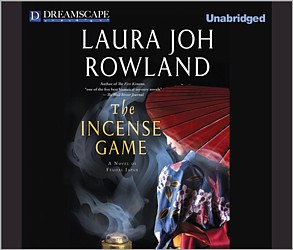
The Incense Game: A Novel of Feudal Japan
Author: Laura Joh Rowland; Reader: Bernadette Dunne
(Audiobook & Original Book - 2012)
Well, I can't say that the idea of a murder mystery set in Feudal Japan didn't seem like a unique and interesting idea to me, but this is another case in which the book is part of a series and I didn't know that until after I borrowed it, and I'm no doubt missing something by not having familiarity with the previous 15 (holy cow!) books.
Concentrating on just the self-contained story within this one, however, it has some interesting plot devices, such as the mystery occurring right after a devastating earthquake that nearly levels the entire city and surrounding areas it takes place in. A lot of visceral imagery arises from this situation. There's also the difficulties the main character, Sano Ichiro, has to contend with arising from the strict honor system of the time, and the fact that war amongst the ruling daimyos could erupt at any moment. But there is a lot of icky weirdness, as well. Some of it made me feel queasy.
The big reveal of the murderer may have had much more of an impact on me if I had been familiar with the character from the previous books. Just having read this one, I was unimpressed, as I've seen that happen a million times. This also isn't "hard fiction", there is a subplot involving mysticism and a ghost samurai that has little to do with the mystery at hand, but is meant to set up another sequel.
In short, this book is probably best for fans of the series. Not a particularly good entry point for the uninitiated, and not much for a good mystery on its own.
Rating: 2.5/5

Treasure Island 
Author: Robert Louis Stevenson; Reader: Michael Prichard
(Audiobook - 2008; Original Book - 1883)
To date, I have seen three different movie versions of Treasure Island: A mediocre Nickelodeon adaptation I reviewed last year, The Muppets Treasure Island, and Disney's reimagined Treasure Planet. So, I have a basic familiarity with the story, though this is the first I've experienced it as intended. Although Robert Louis Stevenson specifically said the story was for young boys, as Roger Ebert claims, children often have a hard time getting through it. I can understand why. Anyone who jumps into it expecting the swashbuckling and treasure hunting to happen right away will be disappointed, possibly even frustrated. The narrative takes its time, lingering on its events and set pieces and gradually building up its story and characters, taking time to explore them all fully before unleashing the action. The treasure hunt is only brief and near the end. But that hasn't stopped Treasure Island from influencing and shaping our modern view of pirates, high seas adventure, and treasure hunting on tropical islands.
There are other factors that make this story more for adults than for children. The main character, Jim Hawkins, is a kid, yes, but it's told from his perspective later in life as an adult, and all the other characters are grown men (and one woman if you include Jim's mother). And though Jim is the narrator/hero, the real star is Long John Silver.
Initially disguised as the ship's cook, the one-legged Silver (whose "wooden leg" is actually a crutch, not a pegleg as sometimes depicted), is the main villain, but yet somewhat of an anti-hero and mentor to Jim, whose father had recently passed away. His complex personality, colorful dialogue, and crafty nature easily make Silver the most interesting character. Despite his cutthroat murderous side, I found myself rooting for him the most. I actually think a retelling of Treasure Island from Long John Silver's perspective would be a very interesting read, if done right.
One impression I got from the book that I hadn't from the movies is that the island itself was a horror of its own. At one point, Jim sees what he thinks are hundreds of noisy, giant slugs on the island's rocky shoreline (revealed to be sea lions). The pirates are unnerved by the sights and sounds along the treasure hunt. And then there's the marooned seaman, Ben Gunn, all reminding us that tropical islands are not just paradises that hide wonderful treasures. Even without pirates around, they're fraught with their own mysteries and danger.
The audiobook reading is decent, with Michael Prichard offering different voices for each character, his best and most prominent being Long John Silver, of course. If you have a mind for adventure, even if you aren't a child, I highly recommend giving Treasure Island a read or a listen, whichever you prefer.
Rating: 5/5







